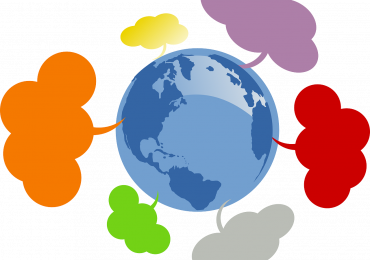The term “superpower” was coined in the Second World War. In 1944, Professor William T R Fox elaborated on the concept. He identified three states as superpowers: the United States, the Soviet Union and the United Kingdom. The UK suffered serious economic problems after the War, and its Empire began to unravel in the post war decades, leaving two superpowers – the USA and the USSR.
The absence of the term ‘superpower’, or some equivalent, before the 1940s is significant. Although there were huge empires – particularly across the land masses of Eurasia – the idea of global power would have seemed impossible. The peoples of different continents lived in ignorance of and, in some cases, completely unaware of the existence of other parts of the world. Global hegemony was impossible when parts of the globe were unknown to each other.
After World War 2, there were just two contenders: the USA and the USSR. And much of the world took “sides”, or at least found itself co-opted into one camp or other. Spheres of influence were generally recognised, and where the boundaries were unclear, they were resolved, often by local wars or confrontations – Korea, Vietnam, the Cuban missile crisis, the post-colonial conflicts across sub-Saharan Africa – establishing spheres of influence as an outcome.
In 1991, the collapse of the Soviet Union left Russia at the heart of the old “Empire”, with its nuclear weaponry intact, but with just half the population of the old USSR, and a much-diminished GDP. Russia was forced to abandon many of its “client states” around the world. The United States became the world’s only superpower. Despite its matchless military power and economic strength, it soon over-committed. Its actions in Iraq and Afghanistan effectively demonstrated the limits of its power, both to the USA itself, and to the rest of the world.
Now, at the beginning of the 21st century, China has clearly expressed its intention to be a superpower to match the USA. And looking further ahead into this century, given India’s size, and economic potential, it is seen by many as a potential superpower.
This blog looks at what are the key components of superpower status, and what political, economic and environmental factors may change what it takes to be a superpower in the future.
What are the Properties of a Superpower?
In his 1988 classic, The Rise and Fall of the Great Powers, Paul Kennedy described seven “dimensions of state power” – which may be summarised thus, in the context of today’s world:
- Geography – being in the right place in terms of history and geopolitics, and at the heart of “where the action is”; since the end of the Cold War, we have seen a shift from the Atlantic to the Pacific, as the main stage.
- Population – it is not really possible to aspire to superpower status without having a very large population – the British Empire circumvented this problem by the co-option of millions of colonised subjects, but Empire seems an unlikely option for the future. The halving of the population due to Russia’s loss of the Soviet “Empire” concerns Kremlin strategists today. The concept of Eurasianism seeks to address this by asserting an underlying “Greater Russian” identity.
- Economy – again the decline of the British Empire and the USSR provide evidence of the fate of superpowers that lack the economic strength to support their aims. Even the USA found the cost of its wars in the Middle East and Afghanistan more than it felt able ultimately to bear. Being a superpower is expensive.
- Resources – it helps an aspiring superpower if it is well supplied with the resources it needs to bolster its economy and its military power. Both the USA and the USSR were relatively well placed in this regard. One of the challenges facing China and India will be how they are able to overcome resource bottlenecks – for example in energy and food.
- Military size and strength – a superpower needs to be able to project power and, when necessary, deploy it effectively and overwhelmingly. Possession of weapons of mass destruction is a sign of “superpowerdom”, but conventional military power are probably of greater utility, given the potentially catastrophic consequences of using nuclear and other WMD.
- Diplomacy – even superpowers need friends. They need support in international forums, such as the United Nations, as well as markets for trade, and allies and supporters in regional disputes. And superpowers will forge alliances with each other. The Partnership Agreement between Russia and China, agreed on the eve of the 2022 Winter Olympics, will have helped embolden President Putin to invade Ukraine.
- National Identity – superpowers need to be able to explain clearly to their own citizens, and to the rest of the world, what they stand for, and why their world view is most cogent and compelling.
Drivers of change for Superpowers
The nature of what makes a superpower, and the challenges they face, are both evolving all the time. For example, as the focus of global strategy moves from the Atlantic to the Pacific, reflecting economic and demographic realities, there is an immediate challenge for Europe, which remains powerful economically, if not so much militarily. How does Europe retain its relative importance in this evolving world?
The rise of new would-be superpowers inevitably challenges the existing world order. Just as Russia’s invasion of Ukraine has led to an escalating confrontation with NATO and the EU, so China’s ambitions to dominate what it sees as its “backyard” sows the seeds of a potential series of confrontations – with the US, Japan, India, Australia, and the members of ASEAN. After the end of the Cold War, global optimists looked forward to a period of consensus, based on international rules. There is today, a stronger flavour of different powers jockeying for competitive advantage. But this brings its own limits. Tomorrow’s superpowers will need to be flexible, asserting their power selectively and strategically, if they are not to overreach and bankrupt themselves.
Access to Resources
The need for superpowers to be self-reliant (even if not self-sufficient) in key resources is itself a driver of change. The Russian invasion of Ukraine has prompted Europe to seek to accelerate its strategic shift from fossil fuels to renewable fuels and energy. By its actions, Russia may have put into hazard, at least in the medium term, the commercial value of its prize asset: its abundant supplies of oil and gas. China and India too are striving to reduce their dependence on energy sources, on which they depend on imports.
Research & Innovation
As well as self-reliance in access to resources and economic power, superpowers need to be agile and innovative. Research and innovation are critical in achieving an advantage, especially in a multi-polar, competitive world.
Changes in technology will challenge actual and potential superpowers to keep ahead of developments. The conflict in Ukraine (and the more localised one last year in the Nagorno-Karabakh region of the Caucasus) suggest that reliance on heavily armoured manned battlecraft (on land and sea) may be becoming a threatened means of projecting power, if not actually a redundant one. The use of hand-launched guided missile systems and drones to attack tanks and ships challenges many current assumptions about warfare. It also raises the question of whether it will be increasingly attritional and expensive for superpowers to occupy the territory of their adversaries, given the damage that resisting forces can do with portable and relatively inexpensive new weapons. This in turn raises questions about how a superpower exercises its power if direct military intervention is riskier, and carries a higher cost. Alliances and diplomacy, especially with regional powers, may become even more important.
Environmental Change
Environmental and global warming are likely to mean that there is no “level playing field”. Although superpowers would be expected to be more resilient against adverse climate impacts than most other states, geography means they may be particularly affected by changes. For example, the spike in temperatures in the Indian sub-continent is an indicator of potentially serious problems ahead, both in access to water and in agriculture. Some changes may be to the geographical advantage of particular states or regions. The opening up of the Arctic due to melting ice offers potential for greater commercial activity in the region, alongside the known dangers of ice melts. Research in Russia envisages scenarios in which its agriculture may benefit from climate change, increasing its importance as a supplier of food, even as other areas are under threat of loss of yields to drought and/or global warming.
Demography
Much of the world, including most of the existing and former superpowers, is facing the prospect of aging population and falling birthrates. The phenomenon was given prominence in Bricker and Ibbotson’s “Empty Planet”. China’s birth rate has fallen from 14.274 births per thousand people in the last year of the last century, to 10,902 births per thousand last year. Its population may already have peaked, and will begin to become smaller in number and older in average age.
How will a superpower comprising increasingly old and middle-aged people seek to operate in the world, as compared with one populated by legions of young people?
Conclusion
Even if the world were inherently stable, the shift to a competing, multipolar system would constantly challenge actual and aspirant superpowers. The drivers listed above show that the world will be even less predictable than under the stable model. It’s catnip for scenario planners.
Written by David Lye, SAMI Fellow
The views expressed are those of the author(s) and not necessarily of SAMI Consulting.
Future-prepared firms outperform the average by 33% higher profitability and 200% higher growth. SAMI Consulting brings 30 years of experience delivering foresight, futures and scenario planning – enabling companies and organisations make “robust decisions in uncertain times”. Find out more www.samiconsulting.co.uk.
If you enjoyed this blog from SAMI Consulting, the home of scenario planning, please sign up for our monthly newsletter at newreader@samiconsulting.co.uk and/or browse our website at https://www.samiconsulting.co.uk



[…] Europe’s nation states have powerful armed forces, but the EU itself has no army, and no strategic command, relying instead on the member states and on NATO. In that very real sense, Europe cannot be said to be a superpower, as described in a previous blog […]